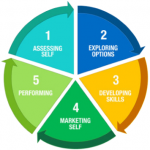INTRODUCTION
The Guidance and Direction for Job Seekers manual, known as GADJ, was developed to aid frontline staff who provide career counselling. As referenced by the University of Texas at Dallas, a thorough career counselling process is a continuous cycle of assessing self, exploring options, developing skills, marketing self, and performing job skills. This manual provides necessary components for comprehensive career guidance, with each component divided by age-appropriate strategies and available resources to advance opportunities.
GADJ is written in a “lesson plan” format for ease of delivery. This second edition of GADJ includes 29 fundamental lessons. We encourage each agency or institution to evaluate their programs and create additional lessons, as needed. See the following for more information.
Purpose of Manual
Career Guidance Cycle (Standards For Each Career Development Phase)
Table_of_Contents
Original Contributing Members

